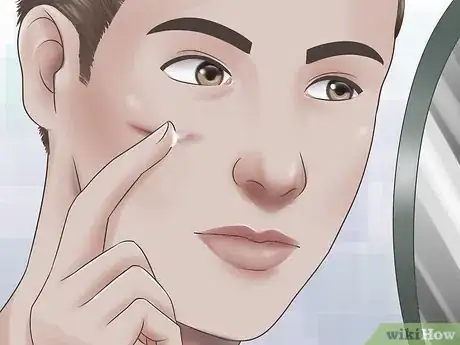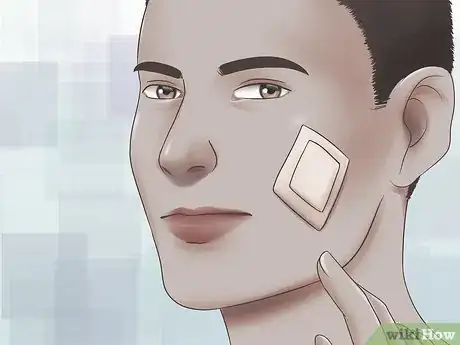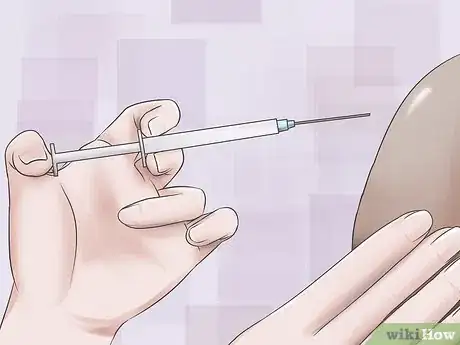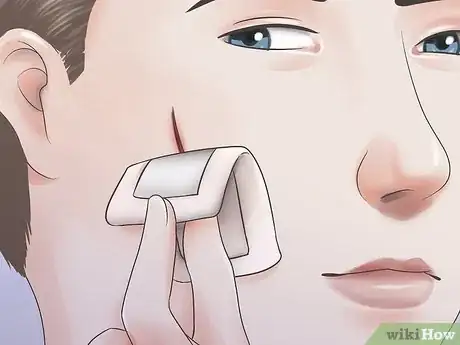This article was medically reviewed by Luba Lee, FNP-BC, MS. Luba Lee, FNP-BC is a Board-Certified Family Nurse Practitioner (FNP) and educator in Tennessee with over a decade of clinical experience. Luba has certifications in Pediatric Advanced Life Support (PALS), Emergency Medicine, Advanced Cardiac Life Support (ACLS), Team Building, and Critical Care Nursing. She received her Master of Science in Nursing (MSN) from the University of Tennessee in 2006.
There are 11 references cited in this article, which can be found at the bottom of the page.
This article has been viewed 665,051 times.
Having a cut on your face can make you feel self-conscious about your looks and can leave you at risk for infection. Luckily, there are steps you can take to help get rid of the cut more quickly.
Steps
Caring for the Wound Immediately
-
1Stop any bleeding. If the cut is actively bleeding, the first step is to stop that bleeding. Do this by applying pressure to the area, using a clean cloth or medical gauze. Do not remove the cloth until the bleeding has stopped completely.[1]
-
2Assess the injury. If the cut is very deep, particularly if it is a puncture wound, you may need to go to the hospital immediately. Large gaping wounds or deep wounds will likely need stitches and professional cleaning. More superficial wounds can be cared for at home.Advertisement
-
3Wash your hands. Before you touch the open wound in any way, be sure to clean your hands thoroughly with soap and hot water. Wash both hands, between all of your fingers, and your wrists thoroughly, rinse with hot water, and dry with a clean towel.[4]
- Hand-washing is a very important method of avoiding the chance of any infection in the wound.
-
4Wash out the cut completely. Clean the wound very gently with water and soap. Be sure to rinse the soap out of the wound completely with water. Be sure to remove any visible debris or dirt from the wounded area.
- Use cool or slightly warm water. Water that is too hot may cause the wound to start bleeding again. [5]
- Be patient and slow with this step. If there is debris in the wound, try using a soft cloth to aid in removing it.
- If necessary, sterilize tweezers with rubbing alcohol and use them to aid in removing pieces of debris from the wound. [6]
- Avoid using hydrogen peroxide or iodine, which can irritate or damage tissue.[7]
-
5Apply treatment to the wound. An antibiotic ointment such as Neosporin or Polysporin is the best option, but if none is available, simple petroleum jelly such as Vaseline can help. Expensive creams or treatments that claim to reduce scarring are generally not as helpful as they claim to be.[8]
-
6Bandage the wound. Place a sterile bandage over the wounded area. This may be a bit cumbersome on your face, but it is important to keep the area free from potential infections.[9]
- Place a bandage over the cut and use medical tape above and below the bandage to keep it in place.
- If the wound is still bleeding, try to secure the bandage tightly over the area. If it is not, a loose covering is adequate.
-
7Use butterfly tape for wide wounds. A wide open cut needs to be pinched together to aid in healing and reduce scarring. Butterfly tape can help pull the skin together and enable it to heal. If this does not work, you will likely need stitches and you should go to the hospital.
-
8Reduce any swelling. If the wound area is swollen (for example, if the cut is the result of a forceful blow), it is important to get the swelling in the area down as well. This can be done by putting ice on the area for 20 minutes at a time.
Seeking Professional Treatment
-
1Go to the hospital if you need stitches. If your wound is wide enough that the skin will not close together on its own, you may need to have stitches. Closing the wound tightly together soon after the injury is essential to reducing scarring and facilitating healing.[10]
- If the wound is in a very visible area on your face, you might want to visit a plastic surgeon to get your stitches done. They can do your stitches more carefully to produce a more aesthetically pleasing result.
-
2Check for broken or fractured bones. If you have received a hard blow to the face, be sure that you do not have any breaks or fractures under the skin. This is especially important if a cut is due to a car accident or any very forceful hit.[11]
-
3
-
4Consult a plastic surgeon in extreme cases. For extreme scarring, you may want to consult a plastic surgeon about the scar area. In some cases, a laser treatment or surgery can be done to reduce the effects of serious scarring.
- It is particularly important to seek help if a scar that had faded turns red, or if the tightness of the scarred area restricts normal facial movement.
-
5Go to the doctor for a tetanus shot. If you have not had a tetanus shot recently, you may need to go get one, depending on the depth of the wound, the object that caused the wound, or your environmental circumstances. [14]
Continuing Treatment
-
1Elevate your head. Try to keep your head above the rest of your body at all times. This may mean using additional pillows at night to prop up the top half of your body. Keeping your head elevated will reduce swelling and pain in the area.[15]
-
2Keep the wounded area still. Excessive shaking or movement will disturb the wound and can delay healing, which may increase scarring. Try to maintain a neutral facial expression and avoid excessive motion.
-
3Keep the cut moist. Keeping an ointment or petroleum jelly applied to the cut will aid in healing and will keep the cut from itching. It is important to refrain from scratching an itchy cut because picking at scabbed areas will intensify scarring.
-
4Change the dressings daily. If you are using bandages to cover the cut, be sure to replace them once every day, or whenever they get dirty or wet.[16] Be sure to use clean, sterile bandages.
-
5Expose the wound to air. After the wound is no longer “open,” it is better to remove the bandage. Exposure to air will aid in quicker healing.[17]
-
6Drink a lot of water. Staying internally hydrated with water will help your body function well and will help keep your wound moist and healing from the inside. Avoid drinking alcohol, particularly when the wound first happens, as it causes expansion and can make bleeding and swelling worse.[18]
-
7Eat a healthy diet. Certain foods are thought to help with the body’s healing. Getting an adequate amount of healing foods, as well as avoiding foods that are high in sugar and unhealthy fats, can help your body heal more quickly.[19] Be sure to eat plenty of the following:[20]
- Protein (lean meats, dairy, eggs, yogurt)
- Healthy Fats (whole milk, yogurt, cheese, olive oil, coconut oil)
- Vitamin A (red fruit, eggs, dark green vegetables, fish)
- Healthy Carbohydrates (rice, whole-wheat pasta, whole-wheat bread)
- Vitamin C (leafy green vegetables, citrus fruit)
- Zinc (meat protein, fortified cereal)
Reducing Scarring
-
1Be vigilant about cleaning and dressing the wound. The best way to avoid a scar is to prevent infection. Proper care in the first two weeks of the wound is the best approach to reduce scarring.
-
2Avoid picking at scabs. It can be very tempting to pick at scabs as they heal. They are often itchy and unsightly. However, it is much better to cover them with ointment and keep them moist. Picking at scabs will make scarring much worse.[21]
-
3Stay out of the sun. Direct sunlight on a sensitive healing area can cause the area to darken and may make scarring worse. If the wound is completely closed, you can apply sunscreen to the area. Before it has completely closed, you may need to avoid sunlight in other ways, like wearing a hat, covering the area, or staying inside.[22]
-
4Try silicone gel sheets. Silicone gel sheets are thin, clear sheets that you apply directly over the cut. These will help keep the wound moist and clean, and encourage quick and healthy healing. You can find them at most medical supply stores. [23]
Expert Q&A
Did you know you can get expert answers for this article?
Unlock expert answers by supporting wikiHow
-
QuestionHow can I get rid of the scars if it has been two years?
 Luba Lee, FNP-BC, MSLuba Lee, FNP-BC is a Board-Certified Family Nurse Practitioner (FNP) and educator in Tennessee with over a decade of clinical experience. Luba has certifications in Pediatric Advanced Life Support (PALS), Emergency Medicine, Advanced Cardiac Life Support (ACLS), Team Building, and Critical Care Nursing. She received her Master of Science in Nursing (MSN) from the University of Tennessee in 2006.
Luba Lee, FNP-BC, MSLuba Lee, FNP-BC is a Board-Certified Family Nurse Practitioner (FNP) and educator in Tennessee with over a decade of clinical experience. Luba has certifications in Pediatric Advanced Life Support (PALS), Emergency Medicine, Advanced Cardiac Life Support (ACLS), Team Building, and Critical Care Nursing. She received her Master of Science in Nursing (MSN) from the University of Tennessee in 2006.
Board-Certified Family Nurse Practitioner Over time, your scars will fade, so you should see them start to improve in appearance. You may be able to speed up the process by using vitamin E oil, a scar healing product like Mederma, or silicone gel sheeting. If you use silicone gel sheeting, you need to apply the sheets for 8-24 hours a day, and it may take months for the scar to improve. Finally, you can ask your doctor about tretinoin cream, which may improve the appearance of scars.
Over time, your scars will fade, so you should see them start to improve in appearance. You may be able to speed up the process by using vitamin E oil, a scar healing product like Mederma, or silicone gel sheeting. If you use silicone gel sheeting, you need to apply the sheets for 8-24 hours a day, and it may take months for the scar to improve. Finally, you can ask your doctor about tretinoin cream, which may improve the appearance of scars. -
QuestionHow do I prevent dark discoloration of a scar?
 Luba Lee, FNP-BC, MSLuba Lee, FNP-BC is a Board-Certified Family Nurse Practitioner (FNP) and educator in Tennessee with over a decade of clinical experience. Luba has certifications in Pediatric Advanced Life Support (PALS), Emergency Medicine, Advanced Cardiac Life Support (ACLS), Team Building, and Critical Care Nursing. She received her Master of Science in Nursing (MSN) from the University of Tennessee in 2006.
Luba Lee, FNP-BC, MSLuba Lee, FNP-BC is a Board-Certified Family Nurse Practitioner (FNP) and educator in Tennessee with over a decade of clinical experience. Luba has certifications in Pediatric Advanced Life Support (PALS), Emergency Medicine, Advanced Cardiac Life Support (ACLS), Team Building, and Critical Care Nursing. She received her Master of Science in Nursing (MSN) from the University of Tennessee in 2006.
Board-Certified Family Nurse Practitioner
Warnings
- Cuts can lead to infection, so watch the injury closely until it heals.⧼thumbs_response⧽
References
- ↑ http://www.webmd.com/first-aid/bleeding-cuts-wounds
- ↑ http://www.healthlinkbc.ca/healthtopics/content.asp?hwid=facei#aa49205
- ↑ http://www.healthlinkbc.ca/healthtopics/content.asp?hwid=facei#aa49205
- ↑ http://www.mayoclinic.org/first-aid/first-aid-cuts/basics/art-20056711
- ↑ http://www.healthlinkbc.ca/healthtopics/content.asp?hwid=facei#aa49205
- ↑ http://www.mayoclinic.org/first-aid/first-aid-cuts/basics/art-20056711
- ↑ http://www.mayoclinic.org/first-aid/first-aid-cuts/basics/art-20056711
- ↑ http://www.webmd.com/a-to-z-guides/wound-care-10/reducing-scars?page=2
- ↑ http://www.webmd.com/allergies/itch-relief-11/cuts-scrapes
- ↑ http://www.mayoclinic.org/first-aid/first-aid-cuts/basics/art-20056711
- ↑ http://www.ucsfhealth.org/conditions/facial_injury/
- ↑ http://www.webmd.com/skin-problems-and-treatments/symptoms-of-infection-after-a-skin-injury
- ↑ https://www.marshfieldclinic.org/sports-wrap/identifying-infected-wounds
- ↑ http://www.mayoclinic.org/first-aid/first-aid-cuts/basics/art-20056711
- ↑ http://www.healthlinkbc.ca/healthtopics/content.asp?hwid=facei#aa49205
- ↑ http://kidshealth.org/teen/safety/first_aid/cuts.html#
- ↑ http://www.mayoclinic.org/first-aid/first-aid-cuts/basics/art-20056711
- ↑ http://www.healthlinkbc.ca/healthtopics/content.asp?hwid=facei#aa49205
- ↑ http://my.clevelandclinic.org/health/healthy_living/hic_What_We_Eat_Affects_How_We_Feel/hic_Keeping_Your_Digestive_Tract_Healthy/hic_Nutrition_Guidelines_to_Improve_Wound_Healing
- ↑ http://www.woundcarecenters.org/article/living-with-wounds/how-your-diet-can-aid-in-wound-healing
- ↑ http://kidshealth.org/teen/safety/first_aid/cuts.html#
- ↑ http://www.webmd.com/a-to-z-guides/wound-care-10/reducing-scars?page=2
- ↑ http://www.webmd.com/a-to-z-guides/wound-care-10/reducing-scars?page=2
About This Article
If you have a cut on your face, you can help reduce scarring by carefully cleaning and dressing the wound during the first two weeks. Always wash your hands before you touch the wound. Keep gauze or butterfly stitches on the wound as it heals and do not pick or scratch at the wound, even if it itches. Try to avoid direct sunlight by staying in the shade or wearing a hat if you have to be in the sun. For tips on caring for a recent wound, keep reading.

























-Step-14.webp)












-Step-14.webp)





































Medical Disclaimer
The content of this article is not intended to be a substitute for professional medical advice, examination, diagnosis, or treatment. You should always contact your doctor or other qualified healthcare professional before starting, changing, or stopping any kind of health treatment.
Read More...